Describe the possible impactss of physiological and psycholo
Describe the possible impacts(s) of physiological and psychological factors on system operation and the completion of a defined mission. Describe the possible impact (s) on each other. Provide some examples.
Solution
The emphasis of aeromedical research has shifted over the past 10 years. The traditional
mission of defining human tolerance to environmental factors and protecting the
aircrew against them has been solved to some degree even if further refinement of tolerance
limits, their quantitative understanding, and the simultaneous and consecutive interaction
of the various stressors deserve further efforts. However, the center of activity has shifted to the performance aspects of the flight environment and to the prediction of
aircrew effectiveness, mission success, and survivability from the complex interaction of
environmental, physiological and psychological factors. To an increasing degree basic
research studies on the physiological effects of specific environments such as acceleration,
heat, vibration and noise were supplemented as realistically as possible by mission
simulations, and by attempts to assess and quantitate aircrew and/or overall weapon sys- tems effectiveness. This trend in laboratory and simulation research clearly enabled a
more realistic and quantitative analysis and optimization in the development of new systems.
The new technologies evolving in the form of more sophisticated physiological, behavioral
and human operator man-in-the-loop models mark progress in these areas. However,
laboratory data and models based on them are always open to criticism, since, in spite of
efforts to simulate the real situation, the lack of realism with respect to environment,
task, motivation and equipment remains. This criticism is still more justified with
respect to extrapolation to combat conditions. The collection and evaluation of opera- tional experiences including combat data collection has probably not progressed as much as laboratory research and simulation. Even if complexity and cost of field studies
explain this state of affairs, it is nonetheless important to realize this deficiency. A
final contribution to the analysis of pilot/aircrew, as well as systems performance, is
provided by accident analysis and interpretati6n.
The various factors which influence pilot performance and which provide direct or indirect clues to his performance assessment are illustrated in figure 1. The human factors
listed in combination with the environmental and operational factors determine his
performance potential. The objective workload imposed on him and the human engineering of his tasks determine to what extent this potential is optimally matched to the system
under consideration. Realistic performance assessment must therefore occur in a closed
loop simulation or through the evaluation of operational mission success. Aeromedical
activity and progress of the last 10 years were to a large extent in the areas listed,
although most of them are 6learly of an interdisciplinary character. Special conferences
and symposia of the AGARD Aerospace Medical Panel dealt over the last three years - in
addition to the conventional problems of aircrew selection and health - with problems in
these areas as indicated by the titles: \"Higher Mental Functioning in Operational Environments\"(1),
\"Vibration and Combined Stresses in Advanced Systems\"(2), \"The Pathophysiology
of High Sustained +Gz Acceleration, Limitation to Air Combat Manoeuvring and the Use
of Centrifuges in Performance Training\"(3), \"Behavioral Aspects of Aircraft Accidents\"(4),
\"Biodynamic Response to Windblast\"(5), \"Escape Problems and Maneuvers in Combat Aircraft\"(6).
The following is a brief review of some of the progress and problems organized around the factors listed in figure 1 as major contributors to pilot performance. (The
Eeparation of these factors is an idealization justified only by the desire for clear
,resentations. In reality there is considerable interaction between them. This is particularly
true with performance as the output measure. Motivation changes performance
under environmental stressors; similarly the engineering of the task and anthropometric factors influence performance for the various environmental and operational factors.)
The discussion is neither complete nor exhaustive but rather a summary of some recent progress
and an illustration of practical experiences feeding back into the aircraft/cockpit/ crew task design.
Pilot Performance/Capability Evaluation and Improvement
a. Human Factors
Anthropometric and kinematic variability of the aircrew member is still at the heart
of many cockpit design problems and is basic to the understanding and alleviation of injuries
to personnel involved in ejection incidents. Although conventional anthropometric data are basically available, functional anthropometric and kinematic data to enable optimum
positioning and motion capability for all cockpit tasks are missing(7). This is particularly
true for new flying tasks and positions, as for example, head-up displays,
sights, or the very high performance fighter aircraft with a high acceleration cockpit.
Motion capability measured both with and without operational personnel equipment, such as the underarm life preserver and coveralls (and not only for the flight systems tasks but
also for the operational combat tasks), must be based on kinematic data as well as static
dimensions. The regular use of computers in cockpit design has made the shortcomings in
this area obvious. The wide variability in just one static dimension such as the sitting
height (figure 2) illustrates the problems one encounters when multi-link motion
~2OcO)/3 O~
23-2
capabilities in new positions must be considered, as for example, with back angles of 650
to 700 (instead of the conventional 130 to 1501 Analysis of ejection statistics gives us a clear indication that pilot stature and position ic an important factor in injury probability.
USAF accident reporting procedures require selected anthropometric data to be
collected on personnel injured upon ejection from aircraft. However, present data acquisition
methods when used by untrained, unspecialized personnel are not providing results
reliable enough for analysis and corrective action. New low cost photogrammetric systems
for this purpose are under development and will hopefully assist future operators in the
field with minimum training.
b. Environmental and Operational Factors
Of the environmental factors, vibration stress during low-altitude, high-speed flight
missions and performance during high G maneuvers in present and future fighter aircraft
have received considerable attention. For both stressors, as well as for other environmental
changes such as heat and altitude (hypoxia), models for the human controller in
the man-machine system have been developed to predict overall system performance under
normal and increasing stress conditions. The potential of this technology to predict
performance decrement under stress is very promising; however, the data base for identification
of operator parameter changes under stress must be broadened before generalized
applications are feasible(8). In addition long-term stress effects such as fatigue or increasing discomfort have not yet been accounted for in these models. However, for the
solution of specific problems, as for example, the optimization of the design of the control
stick for the vibration environment, the state-variable or \"optimal-control\" model
for the pilot/vehicle system has proven to be very useful(9). In this particular model
the operator\'s error is analyzed in terms of a component correlating with the signal
input and two components caused by the vibration effects: the vibration correlated feedthrough
and the additional remnant or noise in the control output (Fig 3). The latter is
split up into perturbation of perception and of control activity. Pilot tracking performance
under vibration was investigated as a function of control stick dynamics (stiff versus spring stick). Separation of the errors into their various components exhibited
the differences shown in figure 4. Theoretical prediction of the errors by use of the
model results in such good agreement with these data (Fig 5), that the model has been
proposed for use in control stick design. Although control stick characteristics influence
primarily vibration feedthrough, which typically accounts for only a small portion
of the increment in tracking error due to vibration, it is nevertheless an important con- sideration if an inappropriate choice of parameters is to be avoided. A practical application
of the model\'s predictive capability is shown in figure 6: in the vibration environment
there is an optimum stick gain at which the output error is a minimum. The mini- mum is caused by the summation of the vibration feedthrough increasing with stick gain and the tracking related error.(remnant) decreasing with increasing stick gain. The
model predicts a limited range of optimal stick gain for the vibration environment compared
to static conditions.
For evaluation of the operational vibration environments of low-altitude, high-speed
flight missions, the exposure criteria for whole-body vibration as defined in the guide
of the International Standards Organization(10) and modified for military applications(ll)
proved to be the best guidance available. These criteria are supported by the limited
body of operational data available(2). An example of their application is illustrated in
figure 7(12). A shortcoming of this guide was its inapplicability to the vibration range
below 1 Hz, where exposure limits are governed by motion sickness, a phenomenon not only
highly variable from subject-to-subject and from situation-to-situation but also a phen- omenon depending upon other sensory inputs besides whole body motion. Evaluation of
newly acquired data and all previously accumulated evidence led to the exposure boundaries
of figure 8(13) as the recommended design guidance whenever extension of human transfer
functions to this very low frequency range is needed for military use. Exposure up
to these levels is expected to result in less than 10% motion sickness in the general
population.
With respect to sustained acceleration stress, work is concentrated on exploiting
the full performance potential and air combat maneuverability offered by future tactical
fighter technology based on high thrust-to-weight ratio engines, advanced lightweight
structures and more effective flight control. That pilot G tolerance is improved by a
reclined position. has been known for a long time (Fig 9). -If this physiological protec- tion was to be used in practical high acceleration cockpit designs, pilot-system flight
effectiveness as well as combat effectiveness at higher G loads had to be proven by ex- tensive studies and simulations. Various designs for articulating seats evolved which
would allow the pilot to assume the reclined position for maneuvering G-protection but
return to the upright position for the remainder of the mission. Two such design concepts
are illustrated in figure 10; the seat rotation does not interfere with the ejection
capability in the normal upright position. Pilot effectiveness is increased as illustrated in figure 11. The design problems with respec~t to anthropometry as well as performance capability for such a two-position seat are enormous; full combat vision,
control of flight and armament functions must be retained for all seat positions. Ejection
capability as well as normal flight efficiency and comfort must not be compromised.
Cockpit design studies demonstrated that such an articulating seat can be integrated into an advanced fighter cockpit to provide full system effectiveness(14). The crew integration
issues addressed are summarized in figure 12. A quantitative estimate of the advantage
of incorporating a high acceleration cockpit into current fighters (7.5 G structure) and into a high acceleration fighter (10.5 GCstructure) was obtained from complete manin-the-loop
real-time combat encounters using experienced fighter pilots and a fixed base
simulator(16). The trend observed in these studies of duels between the HAC-equipped
23-3
fighters against conventional fighters is illustrated in figure 13. Other manned simulation
studies to measure combat effectiveness for various starting conditions for the
fight all support this trend and emphasize that design for physiological protection and
combat performance effectiveness can go hand in hand and can bring about the hoped for
results.
Another environmental and/or human factor to be mentioned which has been investigated extensively with respect to its effect on pilot performance and air\'operations is the
circadian biorhythm, modulating the activity of most body functions over the daily 24-
hr period. In this area too, emphasis shifted from physiological studies to performance evaluations. The vast amount of evidence accumulated(17) shows that human performance as a function of the time of day shows a similar fluctuation as the physiological functions
(Fig 14). Performance basically follows the rhythm of body temperature. The
range of oscillation of the various performance measures varies between 12% and 25% of
the 24-hour mean whereas the physiological fluctuations are much higher. The general
dependency illustrated in figure 14 can be modified within limits by disposition,.training,
motivation, personality, change of the sleep-rest cycle and changes in the environment.
The latter two are typical factors in air operations which lead to desynchronization
of the performance rhythms and a temporary lowering of the 211-hour mean perform- ance. The time constants for desynchronization and subsequent resynchronization have
been extensively studied in laboratory, as well as operational transatlantic experiments
with transmeridian time shifts, over 6 and 8 hours. The results have led to several
recommendations with respect to the scheduling of night duty in general and the scheduling
of transmeridian flights and world-wide operations in general. Disregard of circadian
desynchronization has been implicated as a potential factor in major civil aviation
accidents. Application of the rules learned in this field appears clearly indicated.
c. Workload
Without going into the complexity of the detailed definitions of the workload con- cept and the various approaches to workload measurements, a few comments on progress
and direction in this area may be in order. Workload is the input load presented to the
operator; its measurement is only meaningful in terms of operator effort, operator capac- ity and the resulting work output. Workload can be characterized by psychological,
physiological and operational criteria, each of these being used by itself successfully
for specific applications; but in reality it is clear that only the sum of these three
factors can give the final answer. In a model such as the one indicated in figure 1
workload is often simplified to the ratio of required crew/equipment performance time
to the time available for execution. Workload capacity has been frequently measured by
introducing one or more auxiliary tasks and evaluating performance on the secondary tasks and influences of the additional task\'s stress on the primary task performance.
Strategy of time sharing and priority assignment is important for the final workload
assessment. Recently, progress in the identification of human controller model parameters
has led to attempts to measure differential changes in the model parameters under
increasing workload or environmental or psychological stress, and to characterize workload
by these parameter changes. This control theory approach is very appealing since
the model parameters are hypothesized to correlate with specific physiological control
parameters and higher mental functions(18)(19). It might primarily be valid for the
traditional pilot functions requiring perceptual and manual control skills. However,
the new types of systems envisioned for future aircraft, making increasing use of on- board computers to select and control a large number of aircrew tasks, change the type
of load and performance requirements imposed on the pilot. Capability to memorize long
sequences of operations and to select between programs and displays are envisioned to
become the primary piloting functions and replace to a large extent manual control task
requirements. As a consequence, assessment methodologies are being developed which
test, in addition to manual tracking, cognitive skills, memory, information processing
and sequencing(20).
Pilot workload is influenced by the human engineering of the man-machine interface.
Modeling of this interface and assessment of the simulated or actual pilot load through
physiological or psychological indicators are only the.initial steps in a human factors
engineering program. It is essential that the researchers, as well as the designers,
receive continuous feedback from operators\' experience. This feedback, the requirement for which is so obvious, is difficult to maintain in today\'s environment of specializa- tion.
d. Mission Success/Accident Evaluation
Physiological and performance studies in the operational environment are difficult
to perform, relatively expensive, and produce data which are usually aircraft and mission
specific and do not allow too much generalization. They are frequently not too
well received by the operators and are therefore seldom done with satisfying thorough- ness - unless there are obvious operational problems. Such problems might be accidents or incidents of impairment of mission effectiveness. Without such problems few operational
studies are done, and the above-mentioned feedback is minimal. The result of
this state of affairs is that intolerable problems are resolved but few tolerable situations
are improved and still fewer good situations are made better. In most mission
studies emphasis is on stress and fatigue, the factors hard to simulate realistically.
A variety of psychological and physiological parameters are being measured and compared
to pretest baseline.studies and to values accumulated from similar investigations.
Scientifically, these studies are often not very exciting, but the sum of the test
results allows a valid judgment of crew effectiveness and/or vulnerability.
i]
23-4
Two recent examples of such tests will be mentioned. The first One was a biomedical
evaluation of the physiological costs of extended airborne command and control operations(21).
In Exercise Night Star the ability of the National Emergency Airborne Command
Post was tested to maintain a continuous airborne alert for an extended period of several
days. Three mission teams of 17 members each were followed through the 4 missions of
8-1/2 to 12 hours duration using both subjective and objective evaluation methods. Physiological
costs were judged from urine analysis, oral temperature, fatigue forms and
sleep histories. Psychological results were obtained from subjective rating of mood,
alertness and coordination, and from critical incident surveys, debriefings and observations.
Physiological evaluation as judged by the metabolic indices indicated mild to
moderate stress of a degree known from previous studies to be compatible with sustained crew performance and not resulting in performance decrement. The work schedule could
have been maintained for additional missions if necessary. Psychologically the exercise
produced only mild fatigue, as demonstrated in figure 15, although the fatigue was always
greater than on the control days. With the exception of the first 12 hour mission, the
fatigue level seldom fell below a score of 9. Experience has shown that complete recov- ery from this fatigue level occurs after an 8-hour sleep. The low score of 6.7 in Team
III after the first mission - a score indicating moderate persistent psychological cost -
was probably the result of the 12-hour alert duty preceding the first 12-hour flight at
the beginning of the exercise. Overall there was only a small indication of cumulative
fatigue in Team III evidenced by the low score early in the fourth mission. In summary, the
test clearly demonstrated that airborne alerts without decrement in performance would be
biomedically feasible for periods longer than Exercise Night Star.
The second example of operational study of biomedical cost involved low-level recon- naissance flying in the RF-4C aircraft(22). The RF-4C pilots and weapon systems operators (total of 47) were evaluated by similar methods as in the previous study. Urine analysis,
L\' >rt rate, oral and skin temperature, and sleep score were the physiological parameters evaluated. The most significant findings pointed toward moderate heat stress and acute
dehydration as a result of missions during the hot summer months. Cockpit temperature (Fig 16) in summer during the high-speed, low-level flight mission was often over 400 C,
and sometimes even over 500 C. It would have been hard to predict from laboratory tests
if and how severe a performance decrement might result from this amount of heat stress.
The operational results (Fig 17) clearly indicated that the photo target acquisition scores deteriorated during the summer months. Nearly twice as many targets were missed
during the summer months than during winter! Completely successful missions were signi- ficantly more likely during winter time. The degree of dehydration found has been observed
in laboratory experiments to result in a 15 to 18% decrease in G tolerance, an additional
stress effect which could have reduced the margin of safety under specific circumstances.
Needless to say that the primary result of this particular study was the recommendation
for improvement of the cockpit air conditioning system of the RF-4C.
The final example to be mentioned of aeromedical investigations based on operational
experience concerns the efforts to reduce the probability of injury to the aircrewman
during escape maneuvers. Unfortunately, in spite of our tremendous technological progress in this area, the probability of injury during escape has not markedly changed over the course of the last 20 years. The reason for this is probably the higher escape speed
and the increased complexity of the systems. Over the past 10 years aeromedical work
focused on the primary injury mode: spinal injury due to the ejection forces. Accident
statistics, detailed analysis of accident reports and laboratory research on spinal dynam- ics and strength led to a biodynamic model of the crewman under the longitudinal acceleration
load. This model allows prediction of the probability of spinal injury for arbitrary
force-time functions and has proven to be a valuable design tool(23). Work on refinement
of this model in conjunction with the evaluation of newly accumulating spinal injury
statistics is going on. In the last few years emphasis shifted to a secondary injury
mode, the injuries caused by the aerodynamic forces after separation of the seat from the
aircraft. Analysis of the statistics and a research effort going individually over the
accident records revealed that the assumption that ejection below 600 knots would. result
in only minor injury was incorrect. Restraint of the crewman proved to be inadequate to
prevent serious injuries due to limb flailing. The probability of flail injury as a function of escape speed is shown in figure 18(24). The overall incidence of major flail
injury in non-combat ejections amounts to approximately 4%, but rises to 22% for ejections above 300 KIAS(25). Since combat ejections appear to occur on the average at almost twice
the escape speed of non-combat ejections, major flail injury in combat ejections was found to occur in 9% of the cases. Of 44 flail injury cases 16 were found to involve
the head and neck, 34 the upper limb and 24 the lower limb. The follow-on program is now directed toward defining the forces acting on the body segments and understanding the
mechanisms leading to limb displacement and tissue failure. Wind tunnel tests with live
subjects in operational clothing seated in various types of ejection seats are aimed at
measuring aerodynamic stability and limb dislodgement forces with the various seats
(26)(27). As an example from the large body of data collected, figure 19 illustrates
the differences in knee separation forces experienced with various ejection control handle
positions. Similarly, data on forces acting on the helmet for different speeds and seat
angles have been collected. Helmet retention and head-neck injury from windblast or on
ground landing - with helmet retained or with helmet lost - are special phases of this
effort. It is hoped that this overall program will define the forces acting on the man and provide the biological exposure limits which are required for the development of protective
countermeasures aimed at either reducing the forces or increasing restraint capability.
The prospect derived from the operational reality that under combat conditions
roughly half of all open seat ejectees face flail injury or fatality(24) emphasizes the
23-5
need for better data and new approaches in this area.
Conclusions
This overview of current aeromedical efforts, achievements and trends and their
relation to operational experiences is by necessity sketchy and incomplete. In addition,
it is probably biased by the author\'s own experiences, and interests. In spite of these
shortcomings it is hoped that it has reviewed some of the major research thrusts which are based on observations, measurements or statistics from the operational environment.
The results lead in most cases to reorientation of laboratory research interests and to
improvements of methods and technologies, which in turn, we hope, contribute to improved
systems concepts, designs and operations. Main progress was probably characterized by
advances in two areas:
a. The technologies of modeling human biodynamic response to force environments,
of modeling human performance under environmental stressors, and of modeling the manmachine
interface have advanced to the point where the models can provide, in many cases,
quantitative design guidance in place of qualitative\'interpretation, to increase safety
and crew performance capability.
b. Efforts to define, measure and predict the aircrews\' capability are generally more directed at evaluating overall weapon systems effectiveness. Physiological and
psychological factors are both studied in more realistic closed-loop laboratory mission
simulations as well as in operational field studies, with the primary goal to characterize
man\'s overall performance capability and limitations as the operator of specific
systems on specific missions.
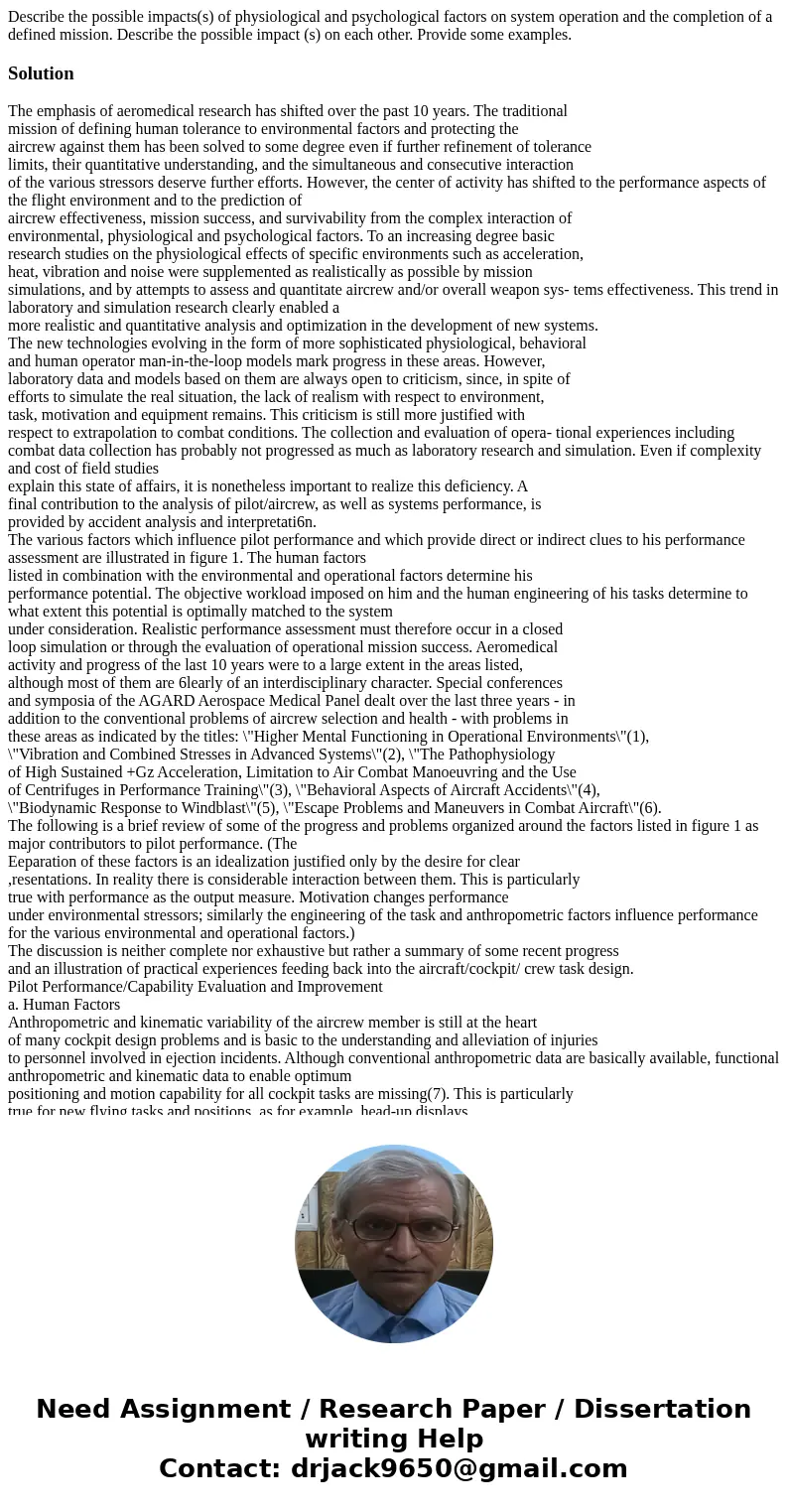
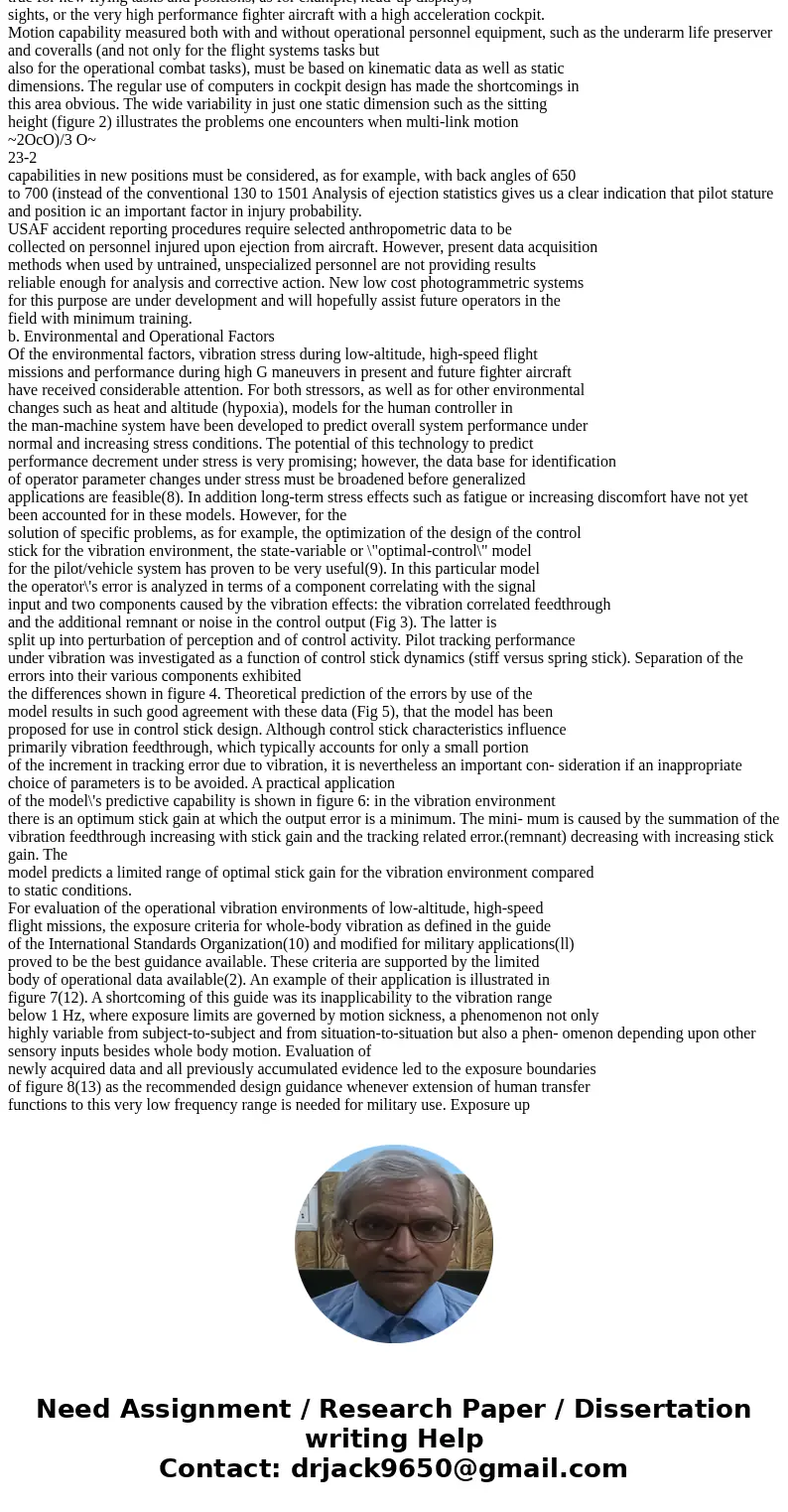
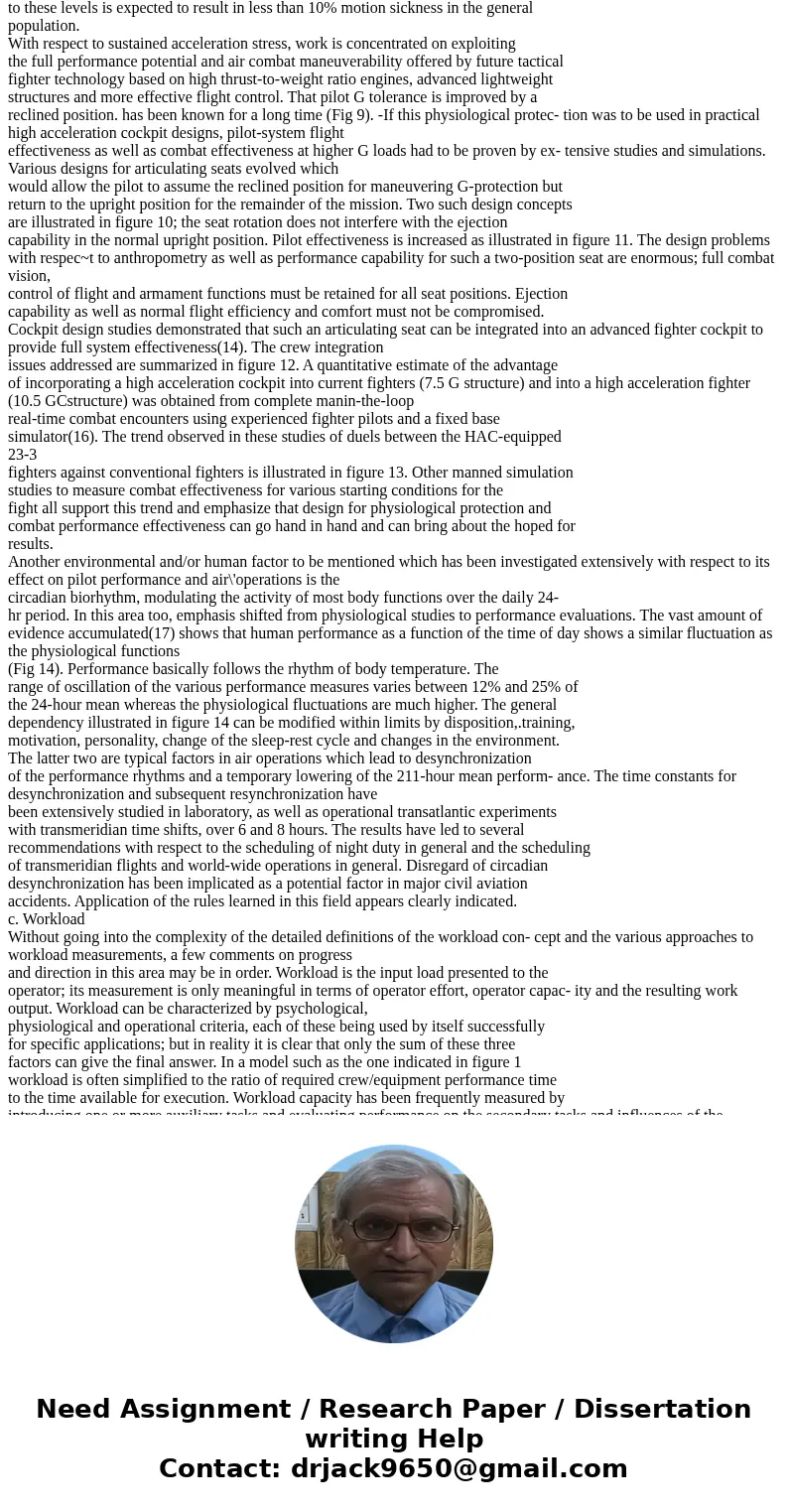
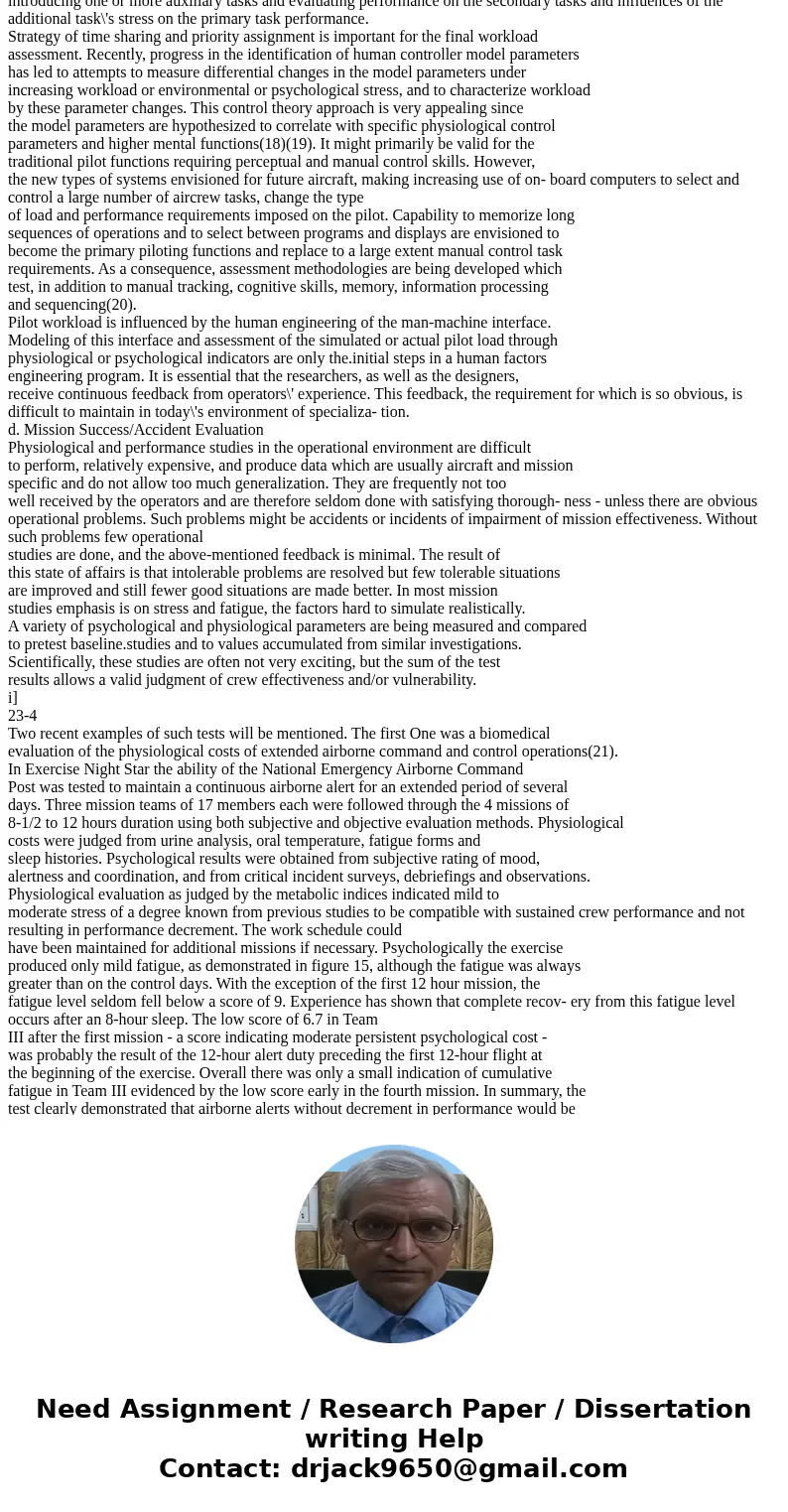
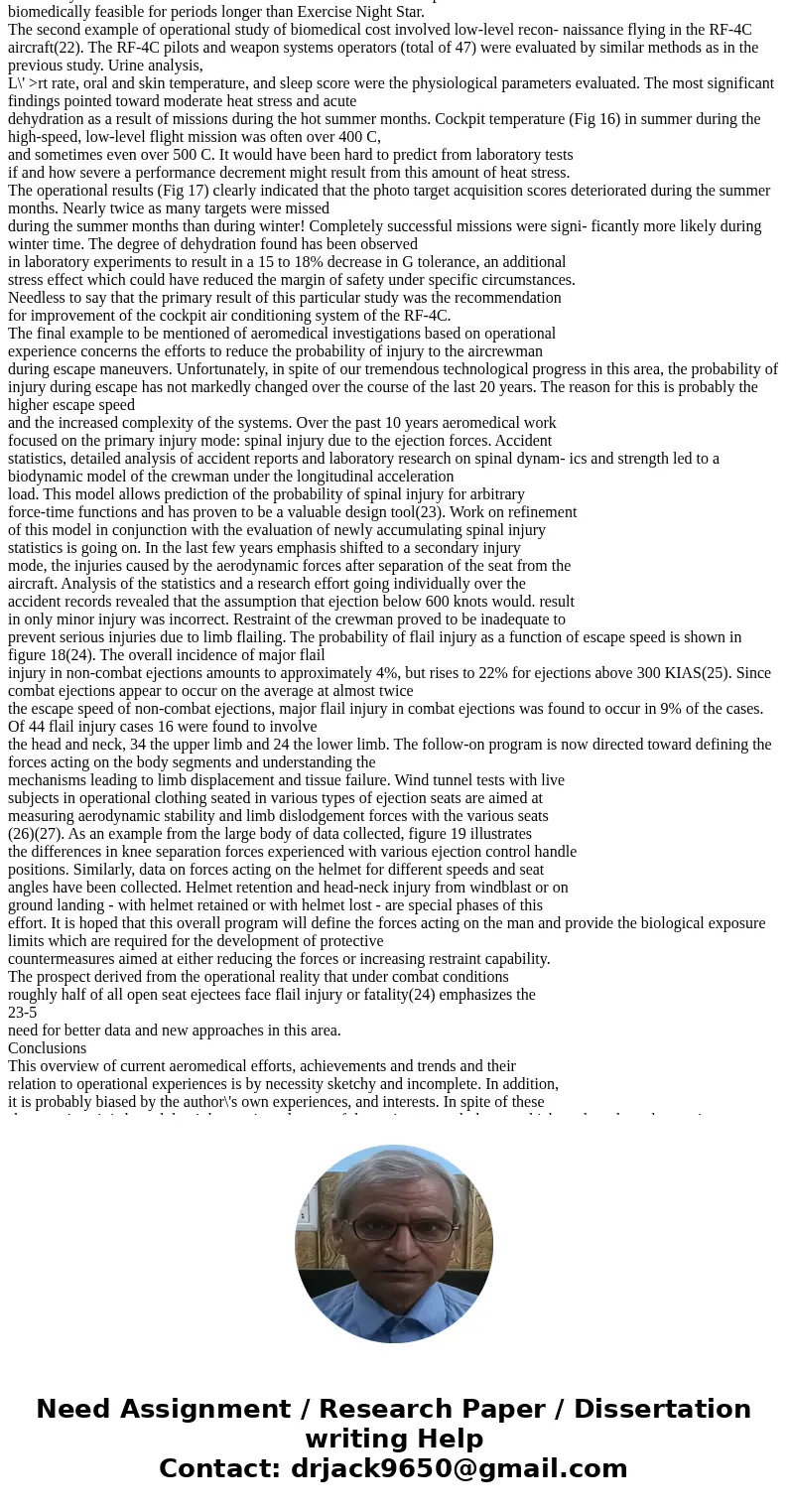
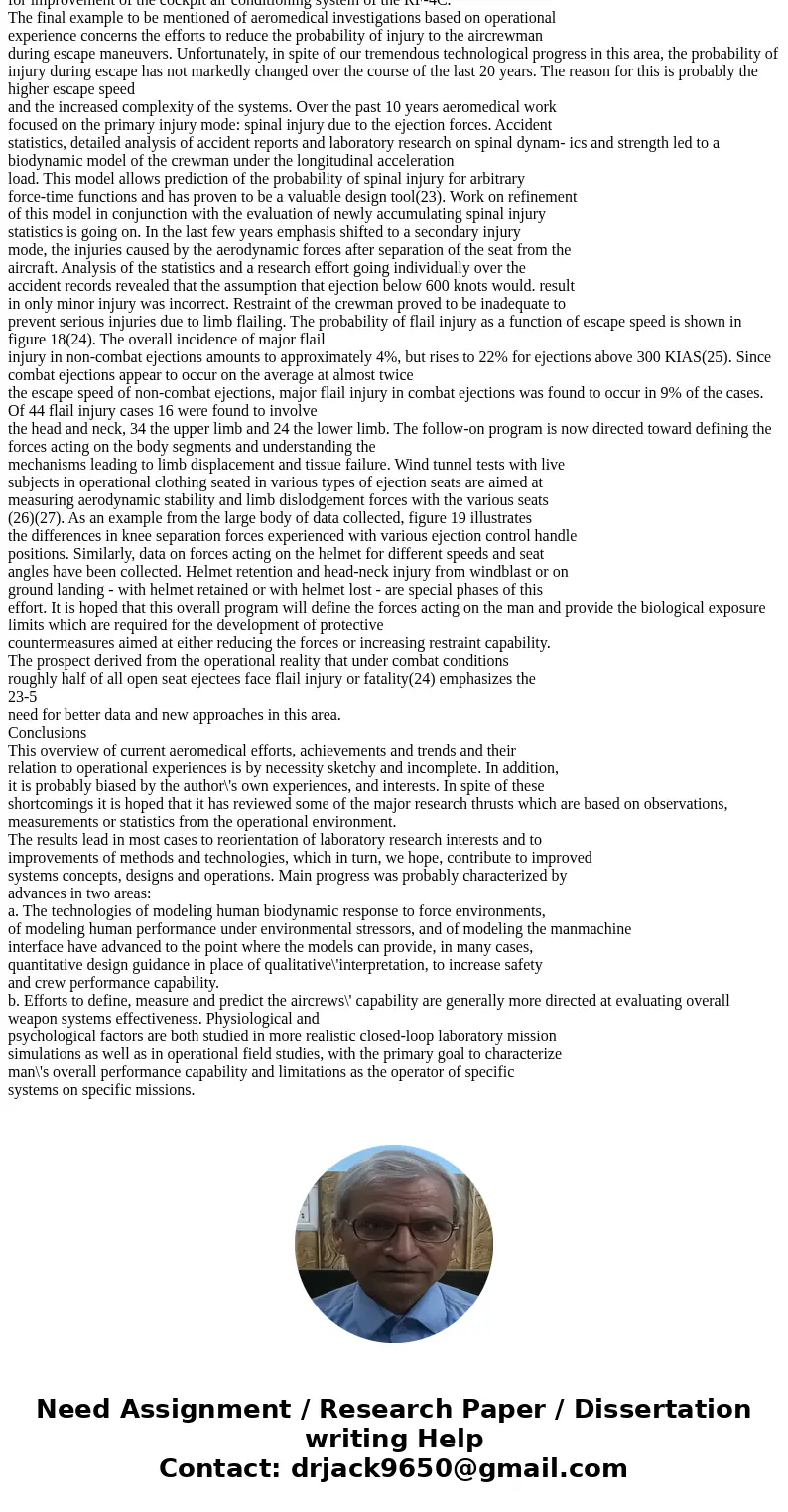
 Homework Sourse
Homework Sourse